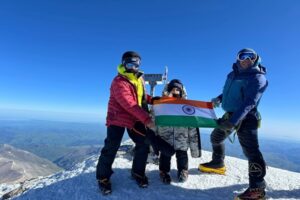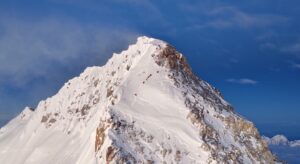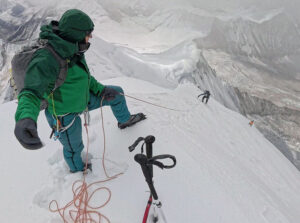On January 8, China lifted its COVID restrictions, suggesting that Everest’s North Side might reopen soon to foreign climbers. That has triggered enthusiasm among international outfitters, Adrian Ballinger of Alpenglow in particular. He has guided Everest only on the Tibetan side since 2015.
“Student and business visas are now operative, with only a PCR required and no quarantine,” Ballinger told ExplorersWeb. “Everybody hopes that tourist visas will follow.”
Just in case, Alpenglow has a team ready to go as soon as the closure lifts. According to one industry rumor, the CTMA (China/Tibet Mountaineering Association) could do that as early as Feb 8. Their annoncement would include details about restrictions or limits. However, Ballinger believes that nothing would be different from pre-COVID 2019.
Why go north
Ballinger has climbed Everest a total of eight times, including a no-O2 ascent of the North Col.
“I feel I’ve had half of my guiding career on each side of the mountain,” he says. However, he prefers the peak’s north side, for a number of reasons.

Advanced Base Camp, with the north face of Everest in the background. Photo: Rob Lea
Ballinger and his team decided to switch to the North Side in 2015. That was one year after a serac fell from the West Shoulder right into the Khumbu Icefall and killed 16 Sherpas.
“That was the fourth season I had witnessed accidents in the Icefall, after 2009, 2011, 2012,” Ballinger said. “It just became too much for me. Asking staff, high-altitude workers, guides, and clients to take that level of risk seemed unreasonable when there is a dramatically safer route on the north side of the mountain.”
Since 2000, the fatality rate has been much higher on the south side, especially for working staff, he points out. Somehow, the casualty rate was even on both sides until that 2014 tragedy. The victims in Base Camp of the 2015 earthquake further tilted the balance. Stricter regulations on the Tibetan side have also helped.
A safer route
Ballinger was in Base Camp on the North Side during that 2015 earthquake. While the tremors were strong there as on the Nepal side, the consequences were radically different.
“There were no casualties,” he said. “Sure, the ground shook and there were rock slides and avalanches. But Tibet’s Base Camp is on a huge plateau, far from the mountain and whatever may fall from it.”
That is also why climbing Everest from the north is safer, says Ballinger.
“The North Side route follows the top of the Northeast Ridge, while the South Side route progresses up valleys,” he explained. “So when a serac/rock/ice chunk falls, it falls right on the climbers. On the North Side, everything falls away from them. Also, there are nearly no crevasses on the standard North Side route.”
In addition to its geographical superiority, Ballinger highlights the “much better management” of expeditions in Tibet. What does he mean?

Caroline Gleich (right) and Carla Perez on the summit in 2019. Photo: Rob Lea
A more controlled experience
“There is a heavier presence of authorities, rules such as no diesel generators (only solar panels), strict waste management, and 5G in Base Camp,” Ballinger said. Only official, electric vehicles can access Base Camp.
“On the route itself, the rope-fixing is done by a professional, government-assigned team, so we avoid the mix of teams and the politics that implies,” he explained. “Disreputable companies are not allowed to operate in China. Some have been kicked out over the past few years.” Ballinger gave no names.
China was especially strict in 2019 when it decided that Nepali operators would not receive permits. This causes near-panic in Nepal’s thriving expedition industry.
Subsequent conversations at a political level took place, and the measures were somehow softened. But the exact terms never became clear, because the pandemic struck at the beginning of 2020, closing China until now.
Some suggest that China will open, but not to everyone. Overall, this uncertainty is one of the reasons why Nepalis are so keen to open a route on Cho Oyu from Nepal. However, it is proving a tougher nut to crack than expected.
More North Side features
“China does not allow over 300 climbers on the mountain, which definitely means less crowding,” Ballinger said.
Also, Chinese climbers cannot apply for Everest until they have completed another 8,000’er. “That is a regulation I would love to see extended to foreign climbers as well,” Ballinger says. Alpenglow itself does not require a previous 8,000m summit from its clients.

Climbers on the summit day, Everest’s North Side. Photo: Rob Lea
Outfitters promoting the South Side usually highlight the strikingly beautiful location at the top of the Khumbu Valley. Yet Ballinger is not sure that trekking up the Khumbu is the best way to acclimatize.
“While a wonderful place, many people are exposed to altitude problems or catch illnesses in the tea houses during the trek to Base Camp,” he said.
Nowadays, some Everest clients use helicopters, but it is still common to trek to Base Camp and climb some 6,000’er along the way.
“On the North Side, we meet in Chengdu, move to Lhasa for a sightseeing day, then drive for two or three days across the Tibetan plateau,” says Ballinger. “We stay in modern hotels with good, hygienic food. We actually drive all the way to a clean, modern Base Camp that is basically at the same altitude as the one on the South Side. So we transport everything in the trucks and don’t have to depend on yaks, helicopters, or porters.
“The mountain equipment is not needed until Advanced Base Camp, which is roughly the altitude of Camp 2 on the South Side [6,400m],” he adds. “So we acclimatize in comfy clothes and sneakers on nearby hills. Such a strategy has a positive impact on the final success rate.”
The North Side route
From ABC, climbers on oxygen take the straightforward route to the North Col. Here, they stay for two days and tag Camp 2 before retreating back to ABC or BC. Then they are ready for the summit push.
On the final climb, they start using oxygen after the North Col, on 4L/minute of O2 flow. They advance a camp a day: Camp 2 at 7,700m, then Camp 3 at 8,300m, which makes a shorter summit day. Those trying without supplementary O2 need more time at the North Col and at C2. They also need to touch 8,000m before their final rest, ideally in Base Camp.

Adrian Ballinger skied down Makalu in 2022, his third 8,000’er on skis. Photo: Adrian Ballinger
Cho Oyu and Shishapangma likely open in September
As for the two other Tibetan 8,000’ers, Cho Oyu and Shishapangma will likely open in the fall, says Ballinger. If so, that would be good news for 14×8,000m peak baggers in general, though not so good for those hoping to rush up this spring.






